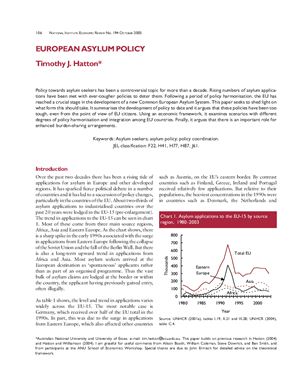National Institute Economic Review, October 2005;
vol. 194, 1: pp. 106-119.
Policy towards asylum seekers has been a controversial topic
for more than a decade. Rising numbers of asylum applications
have been met with ever-tougher policies to deter them.
Following a period of policy harmonisation, the EU has reached
a crucial stage in the development of a new Common European
Asylum System. This paper seeks to shed light on what form
this should take. It summarises the development of policy to
date and it argues that these policies have been too tough,
even from the point of view of EU citizens. Using an economic
framework, it examines scenarios with different degrees of policy
harmonisation and integration among EU countries. Finally,
it argues that there is an important role for enhanced burden-
-sharing arrangements.
vol. 194, 1: pp. 106-119.
Policy towards asylum seekers has been a controversial topic
for more than a decade. Rising numbers of asylum applications
have been met with ever-tougher policies to deter them.
Following a period of policy harmonisation, the EU has reached
a crucial stage in the development of a new Common European
Asylum System. This paper seeks to shed light on what form
this should take. It summarises the development of policy to
date and it argues that these policies have been too tough,
even from the point of view of EU citizens. Using an economic
framework, it examines scenarios with different degrees of policy
harmonisation and integration among EU countries. Finally,
it argues that there is an important role for enhanced burden-
-sharing arrangements.

